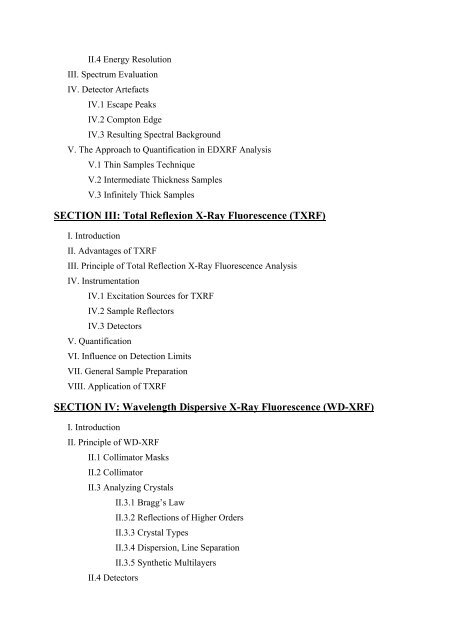X-Ray Fluorescence Analytical Techniques - CNSTN : Centre ...
X-Ray Fluorescence Analytical Techniques - CNSTN : Centre ...
X-Ray Fluorescence Analytical Techniques - CNSTN : Centre ...
Create successful ePaper yourself
Turn your PDF publications into a flip-book with our unique Google optimized e-Paper software.
II.4 Energy Resolution<br />
III. Spectrum Evaluation<br />
IV. Detector Artefacts<br />
IV.1 Escape Peaks<br />
IV.2 Compton Edge<br />
IV.3 Resulting Spectral Background<br />
V. The Approach to Quantification in EDXRF Analysis<br />
V.1 Thin Samples Technique<br />
V.2 Intermediate Thickness Samples<br />
V.3 Infinitely Thick Samples<br />
SECTION III: Total Reflexion X-<strong>Ray</strong> <strong>Fluorescence</strong> (TXRF)<br />
I. Introduction<br />
II. Advantages of TXRF<br />
III. Principle of Total Reflection X-<strong>Ray</strong> <strong>Fluorescence</strong> Analysis<br />
IV. Instrumentation<br />
IV.1 Excitation Sources for TXRF<br />
IV.2 Sample Reflectors<br />
IV.3 Detectors<br />
V. Quantification<br />
VI. Influence on Detection Limits<br />
VII. General Sample Preparation<br />
VIII. Application of TXRF<br />
SECTION IV: Wavelength Dispersive X-<strong>Ray</strong> <strong>Fluorescence</strong> (WD-XRF)<br />
I. Introduction<br />
II. Principle of WD-XRF<br />
II.1 Collimator Masks<br />
II.2 Collimator<br />
II.3 Analyzing Crystals<br />
II.3.1 Bragg’s Law<br />
II.3.2 Reflections of Higher Orders<br />
II.3.3 Crystal Types<br />
II.3.4 Dispersion, Line Separation<br />
II.3.5 Synthetic Multilayers<br />
II.4 Detectors


